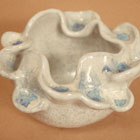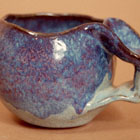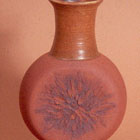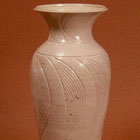LYNN JOHNSON
artwork
audio 
- School (59 sec. | 410KB): listen | read
- Music v. art (35 sec. | 247KB): listen | read
- Son's death (57 sec. | 390KB): listen | read
- Pottery (60 sec. | 412KB): listen | read
- Motivation (52 sec. | 353KB): listen | read
- Creating (52 sec. | 361KB): listen | read
artist statement
When I really got into clay during my junior year in college, I was hooked. What developed then was a life-long love affair with clay. The feel of clay, its versatility, the textures, the colors of glazes, and the variety of forms and techniques are endless.
My pottery is all about form and feel. In general, my wheel thrown pieces lean more toward classical forms, and my handbuilt and sculptural pieces are more organic—forms derived from nature. I think an appealing form is essential to the aesthetic appreciation of a piece. An appropriate weight contributes to this also.
My greatest joy as an artist is in the creation of the forms—working directly with the clay in my hands. I love the texture of the clay, whether rough or smooth or a contrast or combination on a single piece. My next greatest joy is to have other people enjoy and appreciate my work—to see and feel the form and texture. I hope that my pieces beg to be touched. That physical contact is essential in fully experiencing my artwork and sensing the energy that went into its creation.
audio text
School
Up until college, I really had a lot more time invested in music than in art. My interest was in art. But I had a couple years of piano early, and then I started violin in fourth grade and viola in sixth grade, and stuck with viola through college.
The art teacher in high school was very set in her ways. Partly because of her and partly because of scheduling in our high school, I couldn't do choir and art at the same time, and I was always in orchestra. So I only had one year of art in high school. And most of it was drawing. But I did get to make one pot—they had a kick wheel in the art room, and officially you weren't able to use that unless you were in Art III, but I talked her into letting me try it once. I made a pot on the potter's wheel in my first attempt. It wasn't very big, but it was a very nice, well-shaped pot.
Music v. art
I don't think I considered music too seriously because I didn't like to practice, and you have to do that when you're a music major. Working on art stuff wasn't like practicing, it was like creating, and so the time that you have to spend and put in, in art is different than in music—at least it was for me. And it was something that I liked to do and wanted to do rather than practicing. Didn't really get involved with ceramics until my junior year. So when I found ceramics, I was hooked. I knew I'd found my thing.
Son's death
My oldest son Todd died in August of '94, very, very suddenly. And so that has changed our lives. And these programs that I do, mostly for churches, I have this commentary, and it talks about God talking to Jeremiah and telling him to go down to the potter's house. It talks about how God, even when things don't go right with the clay or with our lives, can still make good out of our lives. And how the clay is specially gifted as opposed to sand or dirt, with the ability to hold its shape when it's dry. Talks about the different colors of people and colors of clay, and kinds of clay and people, and our different talents and abilities. So in the last year and a half when I've been doing these, I always share my testimony and talk about Todd, and talk about how God comforted me and got me through that. And it has been a much more powerful program than just the pottery part.
Pottery
I like things that are unique. I like things that are different. Form and feel or texture are the biggest concerns that I have—that the form is right. One of the things I like so much about clay, about pottery, is that it is intended to be felt and touched and picked up and held, as opposed to paintings or drawings or photographs that you look at on the wall but do not touch. I like the fact that people can, most of the time anyway, touch my artwork.
I wouldn't call myself a production potter; I really think I'm more of a one-of-a-kind type. I try to force myself sometimes to do six or eight of the same thing with some little variations. I get really bored doing the same thing, exactly the same [way] over and over again. I don't do as much hand-building as I do throwing, but I like what I can do with coil pots or pinch pots so that they aren't perfectly round.
Motivation
Other than money, which is not the main motivation, just the joy of working with clay and creating. I think most artists make art because that's what's in them. If you're truly an artist, it's just in you to create. I just enjoy creating, working with my hands, and working with something that is pliable that I can manipulate in my hands, and creating a beautiful form that can be enjoyed—either used and/or enjoyed—just to be looked at.
In clay and pots I like variety, and in life I like variety. I have a lot of interests and a lot of talents and sometimes [that's] a blessing and sometimes that's a curse, because it's hard to really focus, as much as I would like to, on my artwork.
Creating
The most satisfying to me is the creating part, the actual working with the clay part. I like the pinch pots, I like the throwing on the wheel, even with its frustrations sometimes. I don't mind the trimming part—that's not quite as creative, though it does have a lot to do with form—when you're trimming the excess clay off the bottom, and really looking at the form of the pot. My least favorite part is the glazing and firing process. Some of those technical frustrations get me down.
It doesn't have to turn out exactly how I envisioned it, but if it turns out well and it's something that I'm pleased with I, again, enjoy holding it, looking at it, and really enjoy seeing other people enjoy my work. The teaching is really satisfying, too. But the most fun part is the making, is the creating—working with the clay itself.





